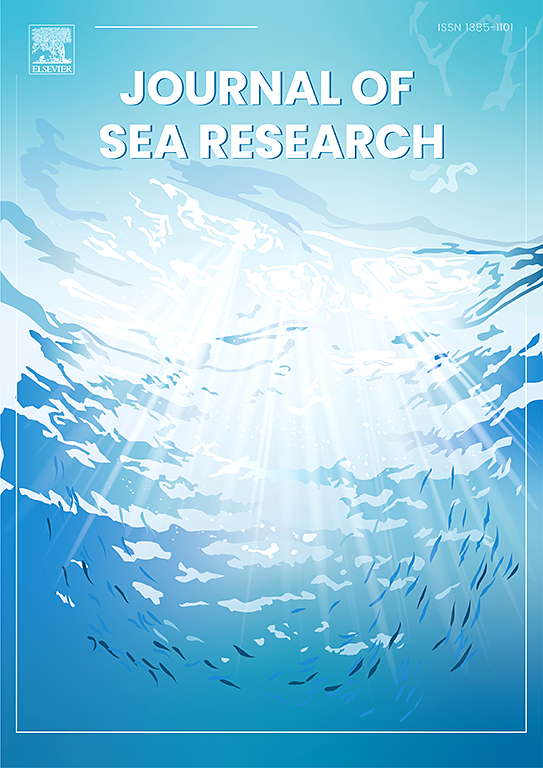大型无脊椎动物附着于膨胀聚苯乙烯海洋塑料碎片表面的招募和演替模式
IF 2.9
4区 地球科学
Q2 MARINE & FRESHWATER BIOLOGY
引用次数: 0
摘要
全球塑料产量一直在稳步增长;然而,关于海洋捕捞活动中常用的膨胀聚苯乙烯(EPS)产品的生态影响的研究仍然有限。本研究调查了大型无脊椎动物在膨胀聚苯乙烯浮标表面的聚集和演替模式,旨在了解群落变化,并为未来的海洋塑料碎片(MPD)管理提供见解。在2022年3月至2023年3月期间,使用刮板每月从长木港的膨胀聚苯乙烯表面取样污染的大型无脊椎动物。在一项招募实验中,每月部署新的膨胀聚苯乙烯浮标;在连续实验中,同时部署了12个膨胀聚苯乙烯浮标,每个实验在研究期间每月回收3个浮标。在聚苯乙烯膨胀表面共鉴定出39种,密度为10,177.4 ind./7.6 m2,生物量为1059.1 g/m2,多样性为0.7。优势种为褐贻贝(40.8%)、马刺胞(29.1%)。物种丰富度、丰度、生物量和多样性呈季节性变化。演替实验表明,群落结构在每个月都有明显的差异,直到浮标部署后5个月才开始形成稳定的群落。值得注意的是,两个引入的物种(Amphibalanus amphilitrite节肢动物和anelida Hydroides elegans)比以前的研究早1-2个月在我们的膨胀聚苯乙烯浮标上定居。总之,这一结果表明,膨胀聚苯乙烯浮标可以作为机会性和引入的大型无脊椎动物的栖息地和扩散载体,可能会导致海洋生态系统的生态干扰。本文章由计算机程序翻译,如有差异,请以英文原文为准。
Recruitment and succession patterns of macroinvertebrates attached to expanded polystyrene marine plastic debris surfaces
Plastic production has been steadily increasing worldwide; however, research on the ecological impacts of expanded polystyrene (EPS) products commonly used in marine fishing activities remains limited. This study investigated the recruitment and succession patterns of macroinvertebrates colonizing the surface of expanded polystyrene buoys, aiming to understand community changes and provide insights for future marine plastic debris (MPD) management. Fouling macroinvertebrates were sampled monthly from expanded polystyrene surfaces in Jangmok Harbor using a scraper between March 2022 and March 2023. In a recruitment experiment, new expanded polystyrene buoys were deployed monthly; in a succession experiment, 12 expanded polystyrene buoys were deployed simultaneously, and in each experiment, three buoys ware retrieved every month during the study period. A total of 39 species were identified on expanded polystyrene surfaces, with a density of 10,177.4 ind./7.6 m2, biomass of 1059.1 g/m2, and a diversity of 0.7. The dominant species were Mollusca Mytilus galloprovincialis (40.8 %), Cnidaria Actinia equina (29.1 %). The recruitment experiment showed seasonal variation in species richness, abundance, biomass, and diversity. The succession experiment demonstrated clear differences in community structure each month until a stable community began to form at 5 months after buoy deployment. Notably, two introduced species (Arthropoda Amphibalanus amphitrite and Annelida Hydroides elegans) settled on our expanded polystyrene buoys 1–2 months earlier than observed in previous studies. Together, this result demonstrate that expanded polystyrene buoys can function as habitats and dispersal vectors for opportunistic and introduced macroinvertebrates, potentially driving ecological disturbance in marine ecosystems.
求助全文
通过发布文献求助,成功后即可免费获取论文全文。
去求助
来源期刊

Journal of Sea Research
地学-海洋学
CiteScore
3.20
自引率
5.00%
发文量
86
审稿时长
6-12 weeks
期刊介绍:
The Journal of Sea Research is an international and multidisciplinary periodical on marine research, with an emphasis on the functioning of marine ecosystems in coastal and shelf seas, including intertidal, estuarine and brackish environments. As several subdisciplines add to this aim, manuscripts are welcome from the fields of marine biology, marine chemistry, marine sedimentology and physical oceanography, provided they add to the understanding of ecosystem processes.
 求助内容:
求助内容: 应助结果提醒方式:
应助结果提醒方式:


